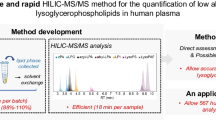Abstract
Plasma lysosphingolipids are highly elevated in patients with Gaucher, Krabbe, Fabry, and Niemann–Pick diseases and tend to accumulate to a greater extent than their respective primary sphingolipids in the plasma of affected patients. In this chapter, we describe two liquid chromatography tandem mass spectrometry (LC–MS/MS) methods to measure plasma concentrations of four lysosphingolipids species. The first method described measures glucosylsphingosine (lyso-GL1) and galactosylsphingosine (psychosine), biomarkers that accumulate in Gaucher and Krabbe diseases, respectively. The second method measures globotriaosylsphingosine (lyso-Gb3) and sphingosylphosphorylcholine (lyso-SPM), biomarkers for Fabry and Niemann–Pick diseases, respectively. Each method utilizes isotope-labeled internal standards and multipoint calibration curves to quantify the analytes of interest. Briefly, plasma samples are mixed with five volumes of LC–MS grade methanol containing internal standard, and protein is removed via centrifugation. Supernatant is dried and resuspended in initial mobile phase. Samples are separated by liquid chromatography using either a BEH amide column (lyso-GL1 + psychosine) or a C18 column (lyso-Gb3 + lyso-SPM). Protonated analytes are measured by selected reaction monitoring (SRM) in positive electrospray ionization mode. Using these methods, we have observed elevations of these lyso- species in Gaucher, Fabry, and Niemann–Pick and successfully distinguished different subtypes reflecting the disease severity.
Access this chapter
Tax calculation will be finalised at checkout
Purchases are for personal use only
Similar content being viewed by others
References
Merrill AH (2011) Sphingolipid and glycosphingolipid metabolic pathways in the era of Sphingolipidomics. Chem Rev 111:6387–6422. https://doi.org/10.1021/cr2002917
Ryckman AE, Brockhausen I, Walia JS (2020) Metabolism of glycosphingolipids and their role in the pathophysiology of lysosomal storage disorders. IJMS 21:6881. https://doi.org/10.3390/ijms21186881
Nilsson O, Svennerholm L (1982) Accumulation of glucosylceramide and Glucosylsphingosine (Psychosine) in cerebrum and cerebellum in infantile and juvenile Gaucher disease. J Neurochem 39:709–718. https://doi.org/10.1111/j.1471-4159.1982.tb07950.x
Orvisky E, Park JK, LaMarca ME et al (2002) Glucosylsphingosine accumulation in tissues from patients with Gaucher disease: correlation with phenotype and genotype. Mol Genet Metab 76:262–270. https://doi.org/10.1016/S1096-7192(02)00117-8
Dekker N, van Dussen L, Hollak CEM et al (2011) Elevated plasma glucosylsphingosine in Gaucher disease: relation to phenotype, storage cell markers, and therapeutic response. Blood 118:e118–e127. https://doi.org/10.1182/blood-2011-05-352971
Mistry PK, Lukina E, Ben Turkia H et al (2017) Outcomes after 18 months of eliglustat therapy in treatment-naïve adults with Gaucher disease type 1: the phase 3 ENGAGE trial. Am J Hematol 92:1170–1176. https://doi.org/10.1002/ajh.24877
Elstein D, Mellgard B, Dinh Q et al (2017) Reductions in glucosylsphingosine (lyso-Gb1) in treatment-naïve and previously treated patients receiving velaglucerase alfa for type 1 Gaucher disease: data from phase 3 clinical trials. Mol Genet Metab 122:113–120. https://doi.org/10.1016/j.ymgme.2017.08.005
Svennerholm L, Vanier MT, Månsson JE (1980) Krabbe disease: a galactosylsphingosine (psychosine) lipidosis. J Lipid Res 21:53–64. https://doi.org/10.1016/S0022-2275(20)39839-4
Turgeon CT, Orsini JJ, Sanders KA et al (2015) Measurement of psychosine in dried blood spots — a possible improvement to newborn screening programs for Krabbe disease. J Inherit Metab Dis 38:923–929. https://doi.org/10.1007/s10545-015-9822-z
Escolar ML, Kiely BT, Shawgo E et al (2017) Psychosine, a marker of Krabbe phenotype and treatment effect. Mol Genet Metab 121:271–278. https://doi.org/10.1016/j.ymgme.2017.05.015
Guenzel AJ, Turgeon CT, Nickander KK et al (2020) The critical role of psychosine in screening, diagnosis, and monitoring of Krabbe disease. Genet Med 22:1108–1118. https://doi.org/10.1038/s41436-020-0764-y
Togawa T, Kodama T, Suzuki T et al (2010) Plasma globotriaosylsphingosine as a biomarker of Fabry disease. Mol Genet Metab 100:257–261. https://doi.org/10.1016/j.ymgme.2010.03.020
Nowak A, Mechtler T, Kasper DC, Desnick RJ (2017) Correlation of Lyso-Gb3 levels in dried blood spots and sera from patients with classic and later-onset Fabry disease. Mol Genet Metab 121:320–324. https://doi.org/10.1016/j.ymgme.2017.06.006
Nowak A, Mechtler TP, Desnick RJ, Kasper DC (2017) Plasma LysoGb3: a useful biomarker for the diagnosis and treatment of Fabry disease heterozygotes. Mol Genet Metab 120:57–61. https://doi.org/10.1016/j.ymgme.2016.10.006
Sakuraba H, Togawa T, Tsukimura T, Kato H (2018) Plasma lyso-Gb3: a biomarker for monitoring fabry patients during enzyme replacement therapy. Clin Exp Nephrol 22:843–849. https://doi.org/10.1007/s10157-017-1525-3
Aerts JM, Groener JE, Kuiper S et al (2008) Elevated globotriaosylsphingosine is a hallmark of Fabry disease. Proc Natl Acad Sci 105:2812–2817. https://doi.org/10.1073/pnas.0712309105
Rombach SM, van den Bogaard B, de Groot E et al (2012) Vascular aspects of Fabry disease in relation to clinical manifestations and elevations in plasma Globotriaosylsphingosine. Hypertension 60:998–1005. https://doi.org/10.1161/HYPERTENSIONAHA.112.195685
Chuang W-L, Pacheco J, Cooper S et al (2014) Lyso-sphingomyelin is elevated in dried blood spots of Niemann–Pick B patients. Mol Genet Metab 111:209–211. https://doi.org/10.1016/j.ymgme.2013.11.012
Wasserstein MP, Diaz GA, Lachmann RH et al (2018) Olipudase alfa for treatment of acid sphingomyelinase deficiency (ASMD): safety and efficacy in adults treated for 30 months. J Inherit Metab Dis 41:829–838. https://doi.org/10.1007/s10545-017-0123-6
Breilyn MS, Zhang W, Yu C, Wasserstein MP (2021) Plasma lyso-sphingomyelin levels are positively associated with clinical severity in acid sphingomyelinase deficiency. Mol Gen Metab Rep 28:100780. https://doi.org/10.1016/j.ymgmr.2021.100780
Author information
Authors and Affiliations
Corresponding author
Editor information
Editors and Affiliations
Rights and permissions
Copyright information
© 2022 The Author(s), under exclusive license to Springer Science+Business Media, LLC, part of Springer Nature
About this protocol
Cite this protocol
Stauffer, B.B., Yu, C. (2022). Plasma Lysosphingolipid Biomarker Measurement by Liquid Chromatography Tandem Mass Spectrometry. In: Garg, U. (eds) Clinical Applications of Mass Spectrometry in Biomolecular Analysis. Methods in Molecular Biology, vol 2546. Humana, New York, NY. https://doi.org/10.1007/978-1-0716-2565-1_25
Download citation
DOI: https://doi.org/10.1007/978-1-0716-2565-1_25
Published:
Publisher Name: Humana, New York, NY
Print ISBN: 978-1-0716-2564-4
Online ISBN: 978-1-0716-2565-1
eBook Packages: Springer Protocols




